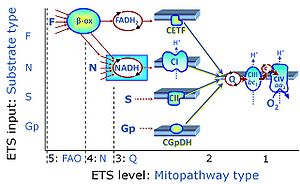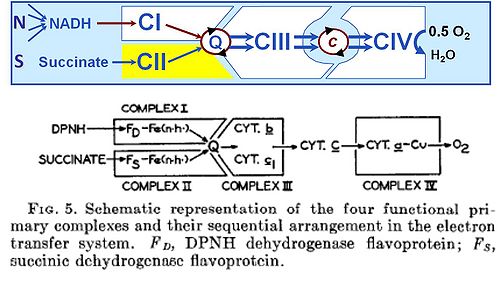Difference between revisions of "Q-junction"
Beno Marija (talk | contribs) |
|||
| Line 1: | Line 1: | ||
{{MitoPedia | {{MitoPedia | ||
|description=[[File:SUIT-catg FNSGp.jpg|right|300px|Q-junction]] | |description=[[File:SUIT-catg FNSGp.jpg|right|300px|Q-junction]] | ||
The '''Q-junction''' is a junction for [[convergent electron flow]] in the [[electron transfer system]] ( | The '''Q-junction''' is a junction for [[convergent electron flow]] in the [[electron transfer system]] (ET-pathway) from type N substrates and mt-matix dehydrogenases through [[Complex I]] (CI), from type F substrates and FA oxidation through [[electron-transferring flavoprotein complex]] (CETF), from succinate (S) through [[Complex II]] (CII), from glycoreophosphate (Gp) through [[glycerophosphate dehydrogenase complex]] (CGpDH), from choline through [[choline dehydrogenase]], from dihydro-orotate through [[dihydro-orotate dehydrogenase]], and other enzyme complexes into the Q-cycle (ubiquinol/ubiquinone), and further downstream to [[Complex III]] (CIII) and CIV. The concept of the Q-junction, with the [[N-junction]] and [[F-junction]] upstream, provides the rationale for defining [[pathway control state]]s and [[categories of SUIT protocols]]. | ||
|info=[[Gnaiger 2009 Int J Biochem Cell Biol]], [[Gnaiger 2014 MitoPathways]] | |info=[[Gnaiger 2009 Int J Biochem Cell Biol]], [[Gnaiger 2014 MitoPathways]] | ||
}} | }} | ||
| Line 52: | Line 52: | ||
== Related MitoPedia pages == | == Related MitoPedia pages == | ||
::* '''Electron transfer system, | ::* '''Electron transfer system, ET-pathway''' | ||
::::» [[Electron transfer system]] | ::::» [[Electron transfer system]] | ||
::::» [[Q-junction]] | ::::» [[Q-junction]] | ||
| Line 60: | Line 60: | ||
::* '''Coupling control state ''E''''' | ::* '''Coupling control state ''E''''' | ||
::::[[File:E.jpg |link=ETS capacity]] [[ | ::::[[File:E.jpg |link=ETS capacity]] [[ET capacity]] | ||
::::» [[Noncoupled respiration]] | ::::» [[Noncoupled respiration]] | ||
::::» [[Uncoupler#Is_respiration_uncoupled_-_noncoupled_-_dyscoupled.3F |Is respiration uncoupled - noncoupled - dyscoupled?]] | ::::» [[Uncoupler#Is_respiration_uncoupled_-_noncoupled_-_dyscoupled.3F |Is respiration uncoupled - noncoupled - dyscoupled?]] | ||
Revision as of 08:44, 20 October 2017
Description
The Q-junction is a junction for convergent electron flow in the electron transfer system (ET-pathway) from type N substrates and mt-matix dehydrogenases through Complex I (CI), from type F substrates and FA oxidation through electron-transferring flavoprotein complex (CETF), from succinate (S) through Complex II (CII), from glycoreophosphate (Gp) through glycerophosphate dehydrogenase complex (CGpDH), from choline through choline dehydrogenase, from dihydro-orotate through dihydro-orotate dehydrogenase, and other enzyme complexes into the Q-cycle (ubiquinol/ubiquinone), and further downstream to Complex III (CIII) and CIV. The concept of the Q-junction, with the N-junction and F-junction upstream, provides the rationale for defining pathway control states and categories of SUIT protocols.
Reference: Gnaiger 2009 Int J Biochem Cell Biol, Gnaiger 2014 MitoPathways
MitoPedia concepts:
MiP concept,
SUIT concept
MitoPedia methods:
Respirometry
MitoPedia topics:
Enzyme
Contributed by Gnaiger E 2010-08-15; edited 2016-02-12, 2016-03-28.
- Convergent NS-linked electron flow at the Q-junction, exerting an additive effect on flux, versus electron gaiting for separation of single N- and S-input pathways (upper panel: Gnaiger 2009; lower panel: Hatefi 1962 J Biol Chem-XLII). Modified Fig. 1.5 in Gnaiger 2014 MitoPathways.
- » Keywords
- Specific
- General
- » Categories of SUIT protocols
- » Choline dehydrogenase
- » Complex I
- » Complex II
- » Dihydro-orotate dehydrogenase
- » Electron-transferring flavoprotein complex
- » Electron transfer system
- » F-junction
- » Glycerophosphate dehydrogenase complex
- » N-junction
- » NS-linked electron flow
- » Pathway control states
- General
Related MitoPedia pages
- Electron transfer system, ET-pathway
- Pathway control states
- Coupling control state E


